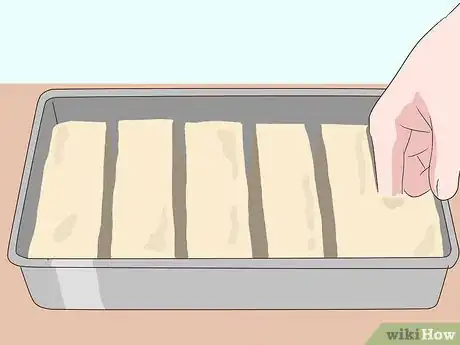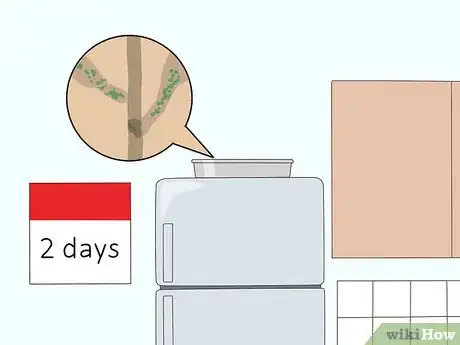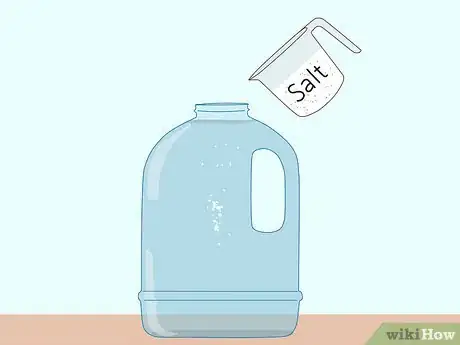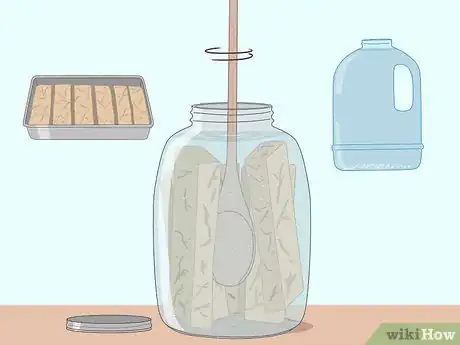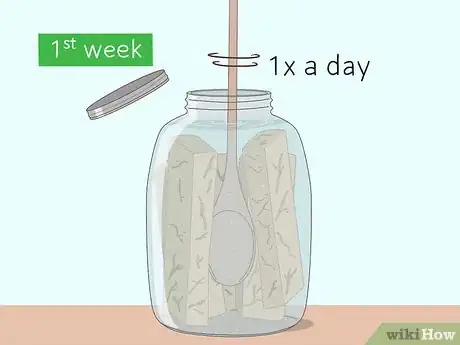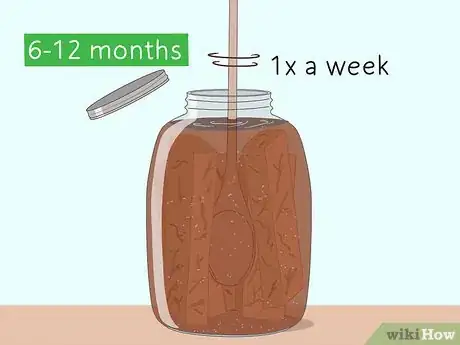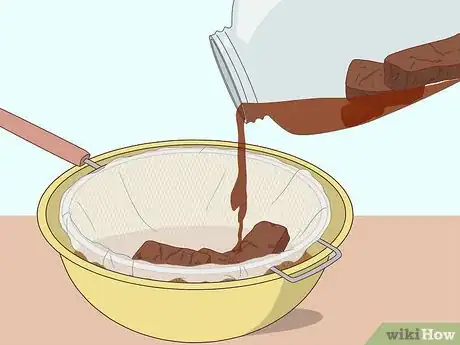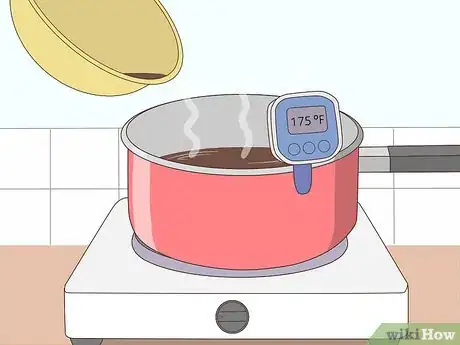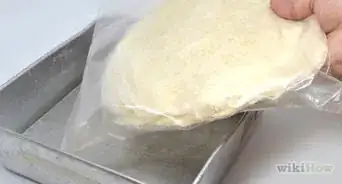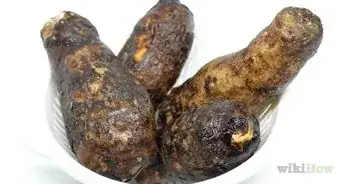This article was co-authored by wikiHow staff writer, Amy Bobinger, and Vanna Tran, a trusted member of wikiHow's volunteer community. Vanna Tran is a home cook who started cooking with her mother at a very young age. She has catered events and hosted pop-up dinners in the San Francisco Bay Area for over 5 years.
wikiHow marks an article as reader-approved once it receives enough positive feedback. In this case, 82% of readers who voted found the article helpful, earning it our reader-approved status.
This article has been viewed 809,890 times.
Learn more...
Soy sauce is one of the most popular condiments in the world, and it’s been used to flavor food for over 2000 years.[1] Making your own soy sauce is a long (and smelly) process, but the final result is a delicious, complex flavor you’ll be proud to serve to your family and friends!
Ingredients
To make 1 gallon (3.8 L) soy sauce
- 4 cups (950 mL) soybeans
- 4 cups (950 mL) wheat flour
- Koji starter
- 1 gallon (3.8 L) water
- 3 1⁄2 cups (830 mL) salt
Steps
Making the Soy Sauce Base
-
1Wash and sort 4 cups (950 mL) of soybeans. You can get soybeans (or edamame) from some grocery stores, although you may need to visit a store specializing in Asian produce.
- Make sure you remove the soybeans from their pods before you soak them.
- If your market makes a distinction between soybeans (mature beans) and edamame (young, softer beans), use the soybeans.
- To wash the soybeans, place them in a colander and rinse them under cold water. Pick out any beans which seem shriveled or discolored.
-
2Soak the soybeans overnight. Place the soybeans in a large pot, then fill the pot with water until the soybeans are completely covered. This should take about 5 quarts (4.7 L) of water. Drain the soybeans and add fresh water to the pot.Advertisement
-
3Boil the soybeans on medium-high heat for 4-5 hours. When they're finished cooking, you should be able to mash the soybeans easily with your fingers.
- You can also use a pressure cooker to cook the soybeans more quickly if you like. Place the beans in the pressure cooker, add about 1 cup (240 mL) of water and close the lid. Place the pressure cooker over high heat, then reduce the heat when the pressure cooker begins to whistle. Cook the soybeans for about 20 minutes.
-
4Mash the soybeans into a paste. Use a food processor, the back of a spoon, or a potato masher to mash the soybeans until they are a smooth consistency.
-
5Mix 4 cups (950 mL) of wheat flour with the soybean paste. This should create a dough-like substance. Knead the mixture together until it’s thoroughly blended.
-
6Add koji starter to your soybean mixture and mix well. Soy sauce gets its flavor from the microbes Aspergillus oryzae and A. flavus. Traditionally, the fermenting mold was developed by allowing the soybean mixture to sit for a week. However, you can purchase the mold spores, known as koji starter, online or from some specialty health food stores.[2]
- Read the packaging to determine the amount of koji starter you should add, as it may vary by brand.
- If your soybeans were still warm when you mixed them with the flour, cool the mixture to about body temperature before you add the starter.
-
7Transfer the koji mixture to a tray that's about 3 inches (7.6 cm) deep. You will leave the koji in the tray while it ferments. Spread the mixture out so it's no more than 2 inches (5.1 cm) deep.
-
8Use your fingers to make furrows in the mixture to increase the surface area. Press down to make long rows through the koji mixture. The furrows should be about 2 inches (5.1 cm) deep and 2–3 inches (5.1–7.6 cm) apart. They should resemble furrows for planting seeds in a garden.[3]
-
9Allow the koji mixture to rest for 2 days in a warm, humid place. This will allow the cultures to develop. You should see the Aspergillus bacteria growing on the soybean and flour mixture. It should appear light to dark green.
- After the 2 days have passed, move on to fermenting in a brine mixture.
- Choose a spot where the koji won't be disturbed as it ferments. The kitchen is ideal if you can handle the smell — try placing the tray in a kitchen cabinet or on top of the refrigerator.
Fermenting and Pasteurizing the Sauce
-
1Dissolve 3 1⁄2 cups (830 mL) of salt in 1 gallon (3.8 L) of water. Pour the salt into the water and stir until it's completely mixed together. This salt water brine will help keep unwanted bacteria from growing as you ferment your koji.[4]
-
2Mix the koji into the brine to create moromi. Place the koji into a large jar with a tight lid. The jar should hold about 2 gallons (7.6 L) of liquid so you'll have room to stir your mixture. Pour your brine over the top of the koji and stir it with a long-handled spoon. The thick koji paste will not dissolve into the brine, but the soy and Aspergillus will begin to seep into the water.[5]
-
3Cover the moromi and stir it once a day for the first week. Keep the moromi in a place with a warm, stable temperature and stir it daily with your long-handled spoon.
- As the koji ferments, it will probably produce a strong odor, so keep it covered tightly when you’re not stirring it.
-
4Stir the moromi once a week for the next 6-12 months. The fermenting process is what really allows the flavors to develop. You’ll need to give your soy sauce at least 6 months to ferment, although for a deeper flavor, you might want to wait up to a year.[6]
-
5Strain the mixture once it's finished fermenting. Once you feel your flavors have developed enough, you should strain your moromi mixture. Place the solids in a press or a piece of cheesecloth to ensure you get all of the liquid out.
- Discard the solids from this process.
EXPERT TIPVanna Tran is a home cook who started cooking with her mother at a very young age. She has catered events and hosted pop-up dinners in the San Francisco Bay Area for over 5 years.Experienced Cook
 Vanna Tran
Vanna Tran
Experienced CookDid You Know? Fermentation results can vary based on the temperature outside of or inside your home. Natural fermentation happens best between 55 and 75 degrees Fahrenheit (13 to 24 degrees Celsius). If the weather is cold and your house is a little cooler than usual, fermentation might take a little longer; if it's hot outside, then your mixture might ferment faster.
-
6Pasteurize the soy sauce by heating it to 175 °F (79 °C). Heat your soy sauce over medium-high heat, then use a thermometer to ensure the mixture stays at this temperature for 20 minutes. Once you have finished pressing the mixture, transfer the liquid to a heat-safe pot and use a candy thermometer to monitor the temperature. Proper pasteurization will ensure there is no harmful bacteria in your soy sauce.
-
7Bottle and serve your soy sauce. Pour your pasteurized soy sauce into a container with a tightly-closed lid and refrigerate it. You may prefer to pour some of your soy sauce into a smaller container to make it easier to serve.
- The finished soy sauce should last for up to 3 years if it's sealed and 1-2 years in an opened container.[7]
Community Q&A
-
QuestionWhy do I have to use mold?
 Community AnswerThe molds make enzymes to help the fermentation process along, some turn starches into sugars usable by the lactobacillus and yeasts that do the fermentation process.
Community AnswerThe molds make enzymes to help the fermentation process along, some turn starches into sugars usable by the lactobacillus and yeasts that do the fermentation process. -
QuestionWhere do I buy soy beans?
 Community AnswerYou can buy frozen edamame (not matured soya beans) in Asian supermarkets and also online.
Community AnswerYou can buy frozen edamame (not matured soya beans) in Asian supermarkets and also online. -
QuestionCan I use soy bean powder instead of the bean pods?
 Community AnswerNo, boiling the beans is the best way. It just won't hold up if you don't use beans.
Community AnswerNo, boiling the beans is the best way. It just won't hold up if you don't use beans.
Things You’ll Need
- Colander
- Bowl for soaking soybeans
- Long-handled spoon for stirring
- Large pot
- Press or cheesecloth
- 3 in (7.6 cm) deep tray
- 2 US gal (7.6 L) jar with tight-fitting lid
- Candy thermometer
- Bottle
References
- ↑ http://www.foodrepublic.com/2017/03/28/make-soy-sauce-asias-seasoning/
- ↑ https://www.researchgate.net/publication/249967710_Study_on_the_Production_of_Fermented_Soybean_Sauce_by_Using_Aspergillus_oryzae_and_Aspergillus_flavus
- ↑ https://thethingswellmake.com/how-to-make-soy-sauce-homemade-shoyu/
- ↑ https://www.researchgate.net/publication/249967710_Study_on_the_Production_of_Fermented_Soybean_Sauce_by_Using_Aspergillus_oryzae_and_Aspergillus_flavus
- ↑ http://www.foodrepublic.com/2017/03/28/make-soy-sauce-asias-seasoning/
- ↑ https://www.japancentre.com/en/pages/94-koji/print
- ↑ https://www.thekitchn.com/how-long-can-you-keep-opened-condiments-tips-from-the-kitchn-45971
About This Article
To make soy sauce, soak the soy beans in water overnight, then boil and mash them into a paste. Add wheat flour and koji starter to the paste and let the mixture rest for 2 days in a warm, humid place. Next, stir moromi into your base once a week for the next 6-12 months to ferment the mixture. Then, strain the mixture and heat the sauce to 175 °F to pasteurize it. Pour your sauce into an air-tight container and refrigerate it for up to 3 years! For more tips on fermenting and pasteurizing your sauce, read on!







